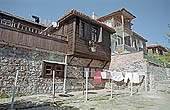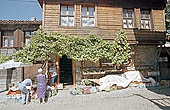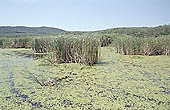The sunny, bright and attractive old town of Sozopol lies on a small rocky peninsula in the farthest southern part of the Bourgas Bay.
Founded by Miletian Greek colonisers in the vii century BC that called the town Apolonia,
after their god of Apollo, after 10 centuries it became known as Sozopol
- 'the town of salvation’.
Today Sozopol is a fishing centre of the Bulgarian Black Sea coast, which also developed a tourism industry. The wooden houses that characterize today the town are from Turkish rule time,
the oldest of these houses can be still seen in the old quarter of the town.
Sozopol architecture from the National Revival period closely resembles that of Nessebur, it falls into the so-called "Black Sea house" featuring stonewalled basements, wooden staircases leading up to the living quarters, wooden scaffoldings, jutting eaves and exterior wood panelling to protect the building from the salty sea air.
The southern vegetation like fig trees and vineyards form part of Sozopol landscape.
Sozopol |

|
Sozopol impacts the visitors as an attractive ensemble with its cobbled stone lanes, old houses with high fences in front of which the old women sit and chat, knit laces and sell jams.
Two ancient churches from the Renaissance period - St. Zosim Church and The Holy Virgin Church.
The houses of Dimitur Laskaridis, who used to be a fish trader (xvii century and now hosting an art gallery), with its wooden façade.

|
Sozopol
|
Outside Sozopol, 20km to the south is the mouth of the Ropotamo River, which is declared a natural reserve.
Sozopol |

|
The Black Sea Coast naturally acts as a major migration corridor (the
via pontica) and our tour was timed to witness the passage of huge numbers of storks that fly south along the Bulgarian coast at that time of year.
|
|
|



